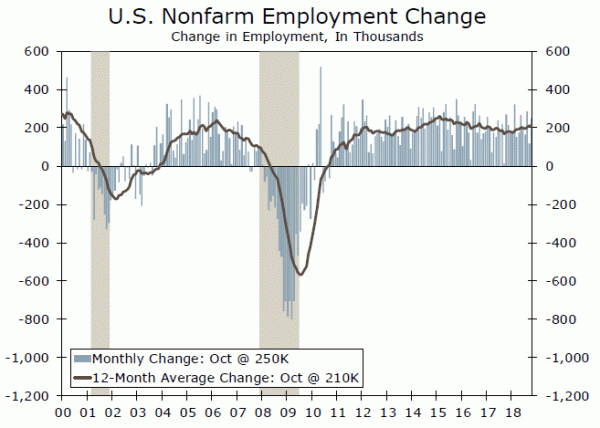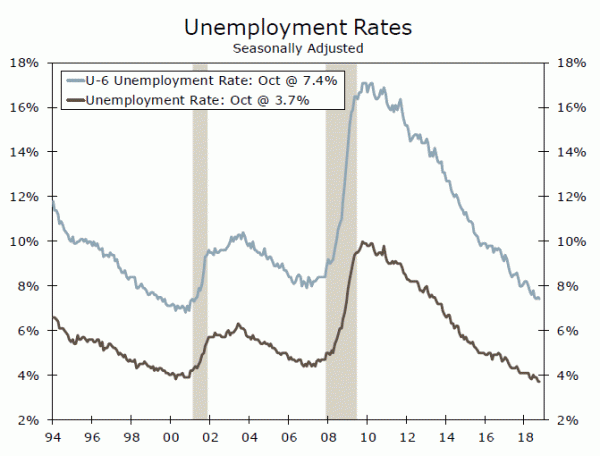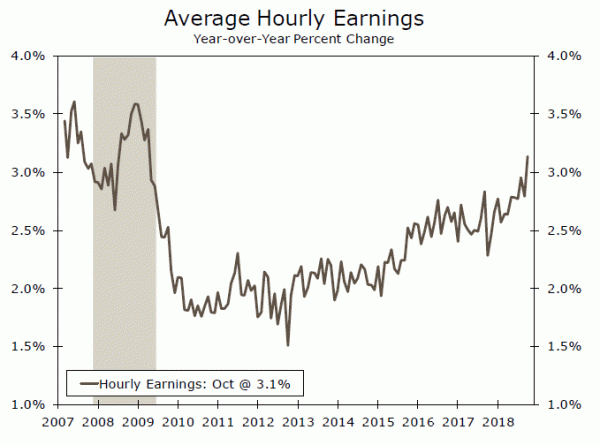Nonfarm employment shot up by 250K in October after hurricane-distorted weakness in September. The unemployment rate held steady, but average hourly earnings rose at the highest rate in this cycle.
Employment Rose Strongly in October
Data released this morning showed that nonfarm payrolls jumped by 250K in October (top chart), which was stronger than most analysts had expected. Despite the sizeable increase in payrolls, the unemployment rate remained unchanged at 3.7% because the labor force rose by 771K during the month. Average hourly earnings rose by 0.2% in October, which matched the consensus forecast.
The strong rise in payrolls in October represents, at least in part, statistical payback for the hurricane-distorted weakness in employment in September. Specifically, jobs in the trade and transportation sector, which contracted by 8K in September, bounced back by 36K in October. Retail trade jobs plunged by 32K in September but rose by 2K last month. Employment in the leisure and hospitality sector was flat in September, but shot up by 42K in October. Of note, jobs in the manufacturing sector rose by 32K in October, the 15th consecutive month of job gains in this sector. Manufacturing employment has risen by 1.3 million jobs since bottoming in early 2010.
Smoothing through the monthly volatility in the overall payrolls number shows that nonfarm employment rose by an average of 218K per month during the August-through-October period, which is in line with the average monthly gain over the past 12 months. In other words, the trend of strong employment gains remains intact.
Labor Market Continues to Tighten
As noted above, the unemployment rate held steady at 3.7% in October. That said, the data show that the labor market tightened further. The U-6 unemployment rate, which is a broader measure of joblessness because it includes workers who have become discouraged and left the labor market (among a few other categories of workers), rose to 7.4% in October from 7.5% in September (middle chart). Not only is this rate of unemployment the lowest in the current cycle, but it is within spitting distance of the October 2000 low of 6.8%.
As also noted above, average hourly earnings rose by 0.2% in October. But due to some sizeable increases in recent months—earnings were up 0.4% in August and another 0.3% in September—the year-over-year increase in average hourly earnings rose to 3.1% in October. Although this rate of wage inflation remains short of the rates that were reached in the late stages of previous cycles, it represents the highest rate of wage inflation in this cycle.
Most analysts expect that the Federal Reserve will hike rates by another 25 bps at its December FOMC meeting, and today’s strong labor market report reinforces that expectation. Looking forward, we look for employment growth to remain generally strong, which should cause the unemployment rate to recede even further. Consequently, we look for the Fed to continue raising rates at a gradual pace into next year.














